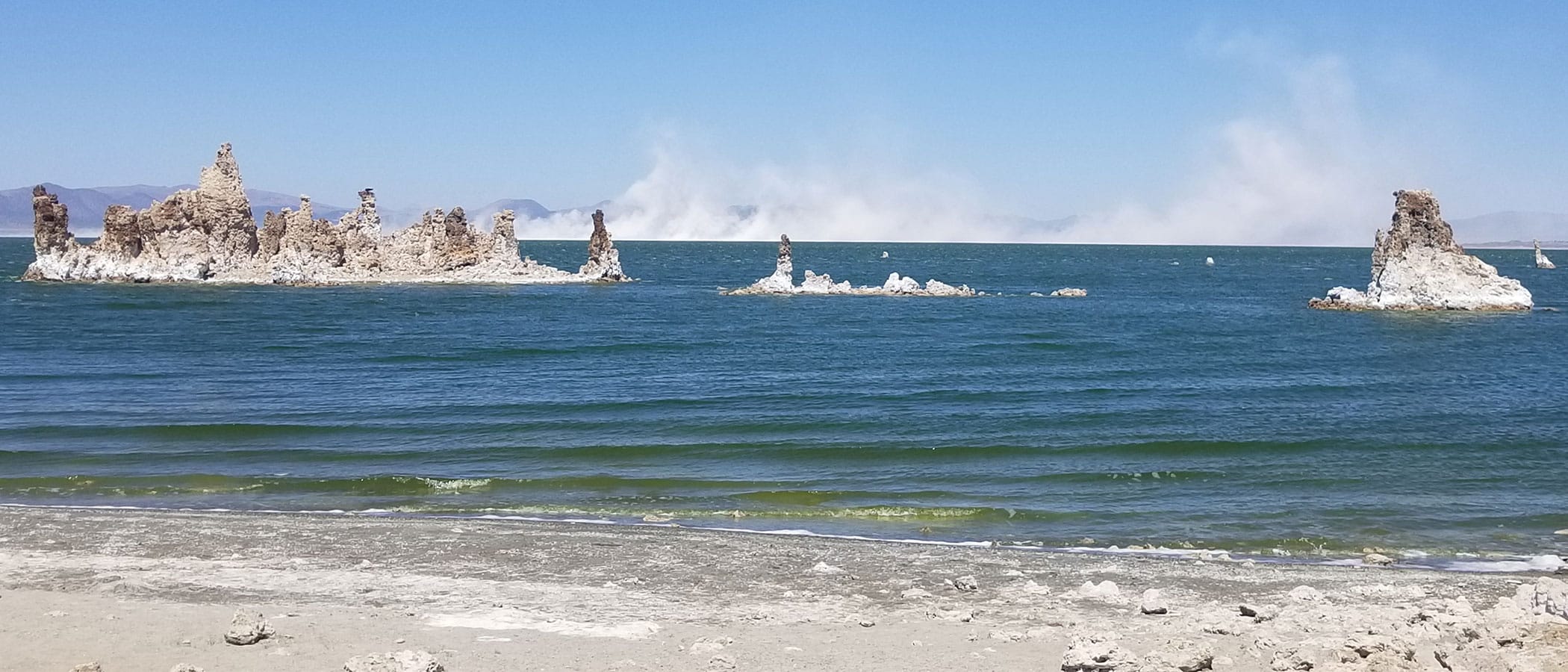
LADWP diversions keep Mono Lake too low, causing multiple impacts
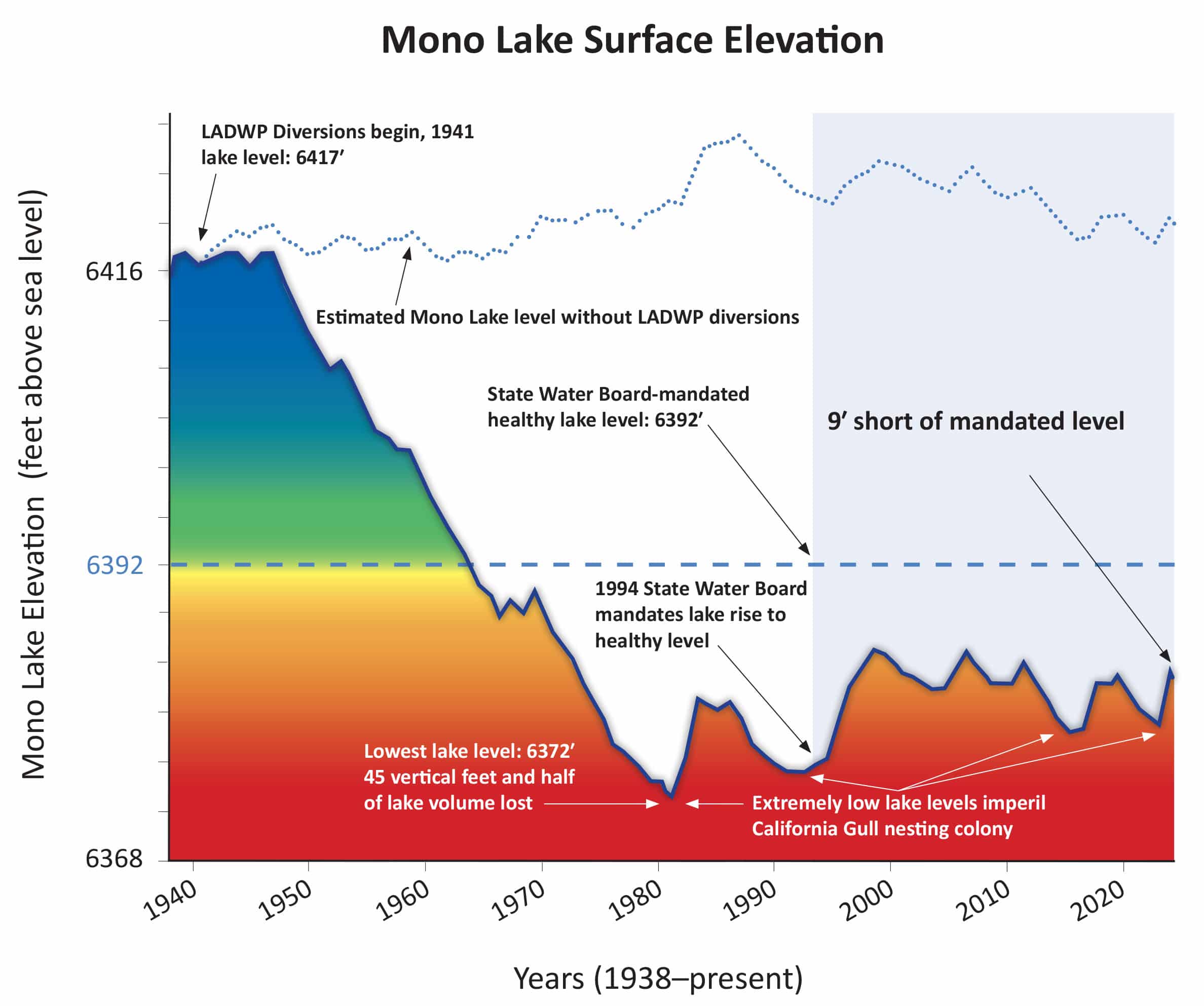
DWP’s water diversions pushed Mono Lake to the brink of collapse and continue to keep it too low.
- Excessive stream diversions by the Los Angeles Department of Water & Power (LADWP) starting in 1941 caused Mono Lake to lose half its volume and drop 45 vertical feet.
- In 1994 the State Water Board mandated that LADWP curtail diversions to allow the lake to rise to the elevation of 6,392 feet above sea level.
- The required lake level was designed to address ecosystem collapse, air quality violations, tufa tower destruction, loss of bird and wildlife biodiversity and habitat, and would protect Mono Lake’s scenic and Public Trust values for future generations.
- LADWP has not complied with the State Water Board’s requirement of raising the lake level. As a result, Mono Lake is suffering the consequences of LADWP’s protracted inaction and the compounding impacts the State Water Board intended to resolve.
- The Mono Lake Committee is advocating raising Mono Lake to the required level of 6,392′.
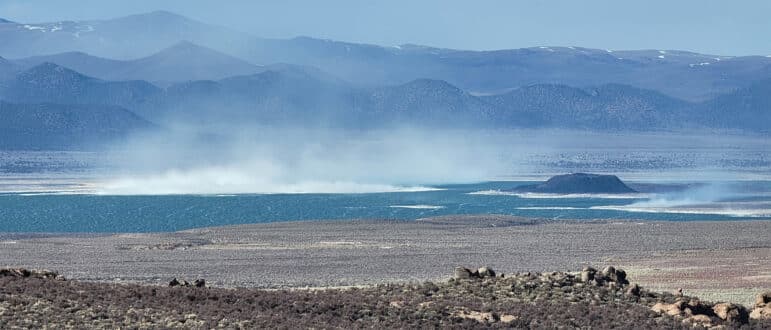
Mono Lake hovers at an artificially low level, generating the worst particulate air pollution in the nation.
- On windy days dust billows off Mono Lake’s dry lakebed which was exposed due to water diversions by the Los Angeles Department of Water & Power (LADWP).
- Dust particles from the exposed lakebed are classified as PM-10, airborne particulate matter with a diameter of 10 microns or less. PM-10 dust can be inhaled deep into the lungs and negatively affect both the lungs and heart.
- The dust events exceed the public health standards of the federal Clean Air Act to such a degree that Mono Lake is often responsible for the worst PM-10 particulate air pollution in the nation.
- In 1994 the State Water Board mandated that DWP curtail diversions to allow the lake to rise in order to “submerge much of the exposed emission source area” and reduce air quality violations.
- The Great Basin Unified Air Pollution Control District is the regional government agency that enforces federal, state, and local air quality regulations that protect people’s health by restricting how much pollution is allowed in the air.
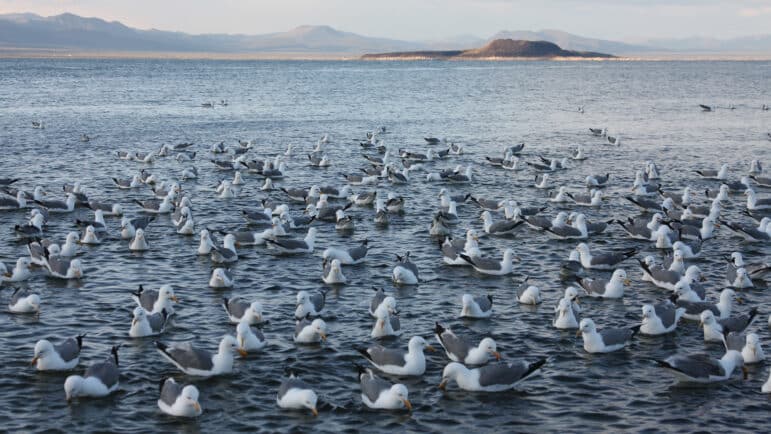
California Gulls are struggling to survive at Mono Lake due to low lake levels.
- Historically, each spring upwards of 40,000 California Gulls migrated inland to breed on the islands in Mono Lake—safe from predators and surrounded by abundant food.
- Excessive water diversions by the Los Angeles Department of Water & Power (LADWP) starting in 1941 lowered Mono Lake 45 vertical feet—exposing a landbridge to the island colony, enabling coyotes to prey on chicks, and threatening to eliminate the colony.
- In 1994 the State Water Board, using California Gull population health as a measure of Mono Lake’s health, required LADWP curtail diversions to allow the lake to rise to protect biodiversity and to restore lake salinity and productivity.
- Since 1994 the level of Mono Lake has cycled up and down without reaching the level needed to ensure California Gull protection. The colony has suffered from repeated landbridge exposure, diminished food availability, and new nesting challenges from an aggressive invasive weed.
- Because of ongoing threats to the gull colony, the Mono Lake Committee has taken protective action—installing a mile-long temporary electric fence to keep coyotes from reaching the gulls and facilitating a prescribed burn to clear the nesting islands.
- In 2024 there was near total nest failure: Over 20,000 adult gulls fledged just 324 chicks lake-wide. In 2023, there were approximately 11,000 chicks—by far the lowest documented. The 1983–2023 average colony size was 42,575 adult gulls.
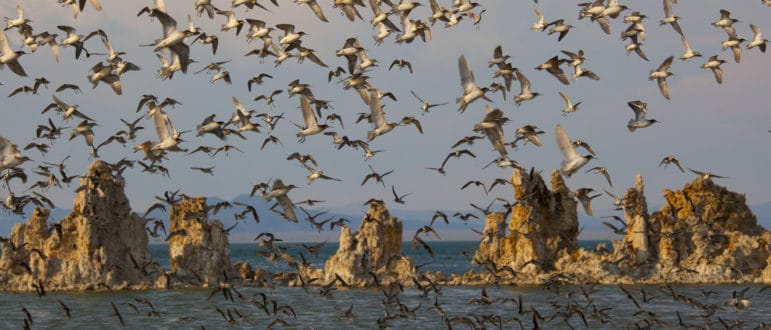
The shrimp and flies that migratory birds depend on are less abundant at low lake levels.
- Brine shrimp and alkali flies thrive in Mono Lake’s saline water, where few other organisms can.
- In summer, Mono Lake is filled with an estimated 4–12 trillion endemic brine shrimp and countless alkali flies both underwater and at the water’s edge.
- Shrimp and flies in abundance feed millions of migrating and nesting birds.
- Brine shrimp and alkali flies primarily eat algae. Low lake levels raise lake salinity, reduce algae growth, and force shrimp and flies to spend more energy just to survive.
- Brine shrimp abundance is particularly important for nesting California Gulls. When shrimp productivity is low or delayed, the health of the gull colony is negatively impacted.
- In 2024 there was an alarming collapse in gull chick hatching and survival for the gull colony. The gulls arrived, nested, laid eggs, and then, it appears there were not enough brine shrimp in the lake to sustain the final stage of hatching eggs and raising chicks.
- Flies are the principal food phalaropes feed on to grow new feathers and migrate 3,000 miles non-stop to South America.
- Alkali fly pupae, known as kootzabe have long been a traditional food for the Mono Lake Kootzaduka’a Tribe. Kootzaduka’a means “fly eater” in the Kootzaduka’a language.
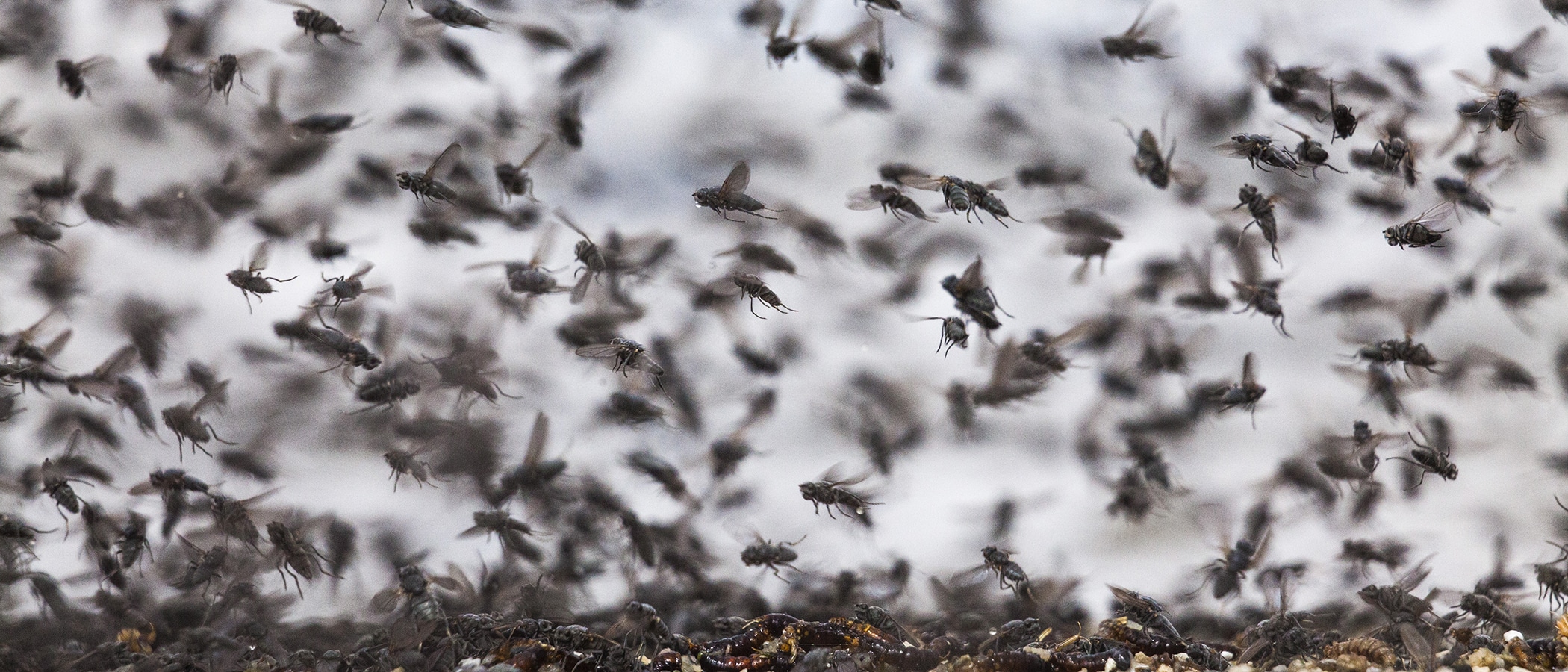
Brine shrimp and alkali flies must work harder to survive the high salinity at low lake levels.
- Mono Lake is a saline lake. Saline lakes support unique biodiversity provide essential food for shorebirds on a global scale.
- In 1941, Mono Lake’s salinity was around 50 grams per liter (g/L), 5.0% salinity, or 50 parts per thousand (ppt). By 1982, the Los Angeles Department of Water & Power’s (LADWP) Mono Basin stream diversions caused Mono Lake to fall 45 vertical feet, which increased salinity to nearly 100 g/L.
- The most severe impacts of high salinity are seen in brine shrimp and alkali fly productivity. Increasing salinity means decreased productivity. The lower the productivity of shrimp and flies, the less food is available for birds—so the effects are seen all the way up the food chain.
- One of the State Water Board’s goals in establishing the required lake level of 6,392′ was to reduce salinity to “maintain the aquatic productivity of the lake in good condition.”
- Mono Lake is designated as an official Outstanding National Resource Water (ONRW), a special designation within the Clean Water Act which includes a salinity requirement.
- The State Water Board is responsible for ensuring that both the lake level (6,392′) and the ONRW salinity requirements are met.
- At 6,392′, Mono Lake’s salinity will be around 68 g/L.
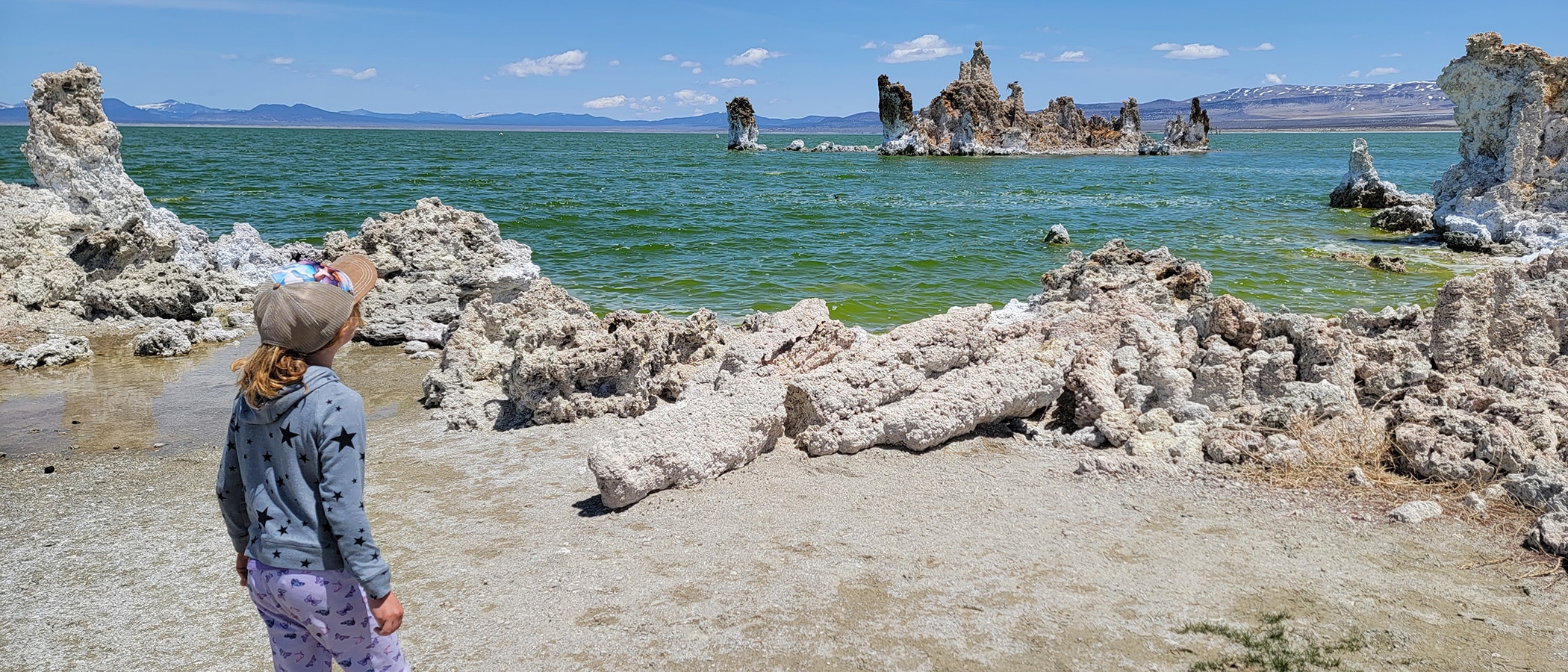
The continued rise and fall of Mono Lake creates a repeated risk of scenic tufa towers toppling.
- Mono Lake’s iconic tufa towers are calcium carbonate rock formations that form underwater. The towers you see today were exposed when water diversions by the Los Angeles Department of Water & Power (LADWP) starting in 1941 lowered the lake level by 45 vertical feet.
- In 1994, the State Water Board took the scenic and ecological values of tufa into account when determining the healthy lake level of 6,392’.
- Though tufa towers are rock formations, they are fragile. Repeated rise and fall in lake level can cause them to erode and topple.
- In 1982 the California legislature established the Mono Lake Tufa State Natural Reserve specifically to preserve and protect tufa for the enjoyment and education of the public.
- Underwater, tufa is used by alkali flies as habitat for grazing algae, laying eggs, and developing into adults.
- Tufa towers are Mono Lake’s iconic landmark; raising the lake keeps them standing for future generations to experience.
